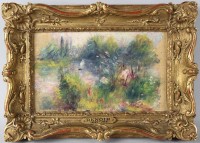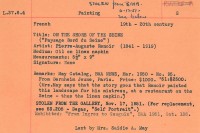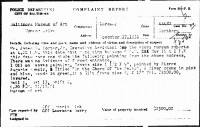 The good news is that the paper trail confirms that Paysage Bords de Seine, the small landscape painting by Pierre Auguste Renoir reportedly purchased along with a plastic cow and Paul Bunyan doll for $7 at the Harpers Ferry Flea Market in West Virginia, is indeed authentic. The bad news is it was stolen from the Baltimore Museum of Art 61 years ago and therefore does not legally belong to the lady who found it. This morning’s planned auction has been cancelled, and the FBI is now on the case.
The good news is that the paper trail confirms that Paysage Bords de Seine, the small landscape painting by Pierre Auguste Renoir reportedly purchased along with a plastic cow and Paul Bunyan doll for $7 at the Harpers Ferry Flea Market in West Virginia, is indeed authentic. The bad news is it was stolen from the Baltimore Museum of Art 61 years ago and therefore does not legally belong to the lady who found it. This morning’s planned auction has been cancelled, and the FBI is now on the case.
The news came as a surprise to the Baltimore Museum of Art. Washington Post reporter Ian Shapira was trying to trace the movements of the painting after it was purchased from the Bernheim-Jeune gallery in Paris by collector Herbert L. May in 1926. May’s ex-wife Saidie Adler May was a major donor to the Baltimore Museum of Art, and many of her papers are kept at the museum’s library. While looking through a box of Saidie’s correspondence and receipts, Shapira found a note recording that she had loaned Paysage Bords de Seine to the museum in 1937.
 The BMA had already checked its ownership records of the vast Saidie May Adler collection when the auction house did its due diligence. There was no mention of the Renoir piece being among the more than one thousand paintings donated to the museum by Mrs. Adler. Nobody even thought to check the loan records until Shapira found the note, which included a loan registration number. Museum director Doreen Bolger looked it up and discovered an orange index card describing the painting, the story behind its creation, its purchase for $1,000 at Bernheim-Jeune and then, in November of 1951, its theft from the Baltimore Museum of Art’s display gallery.
The BMA had already checked its ownership records of the vast Saidie May Adler collection when the auction house did its due diligence. There was no mention of the Renoir piece being among the more than one thousand paintings donated to the museum by Mrs. Adler. Nobody even thought to check the loan records until Shapira found the note, which included a loan registration number. Museum director Doreen Bolger looked it up and discovered an orange index card describing the painting, the story behind its creation, its purchase for $1,000 at Bernheim-Jeune and then, in November of 1951, its theft from the Baltimore Museum of Art’s display gallery.
A shocked Bolger called Elizabeth Wainstein, president of the Potomack Company, the auction house where the painting was to be sold, who immediately agreed to stop the sale. Together they called the FBI to report the theft. Further research revealed a City of Baltimore police report (pdf) from November 17th, 1951 in which James M. Porter Jr., Executive Assistant at the museum, declares that “some time between 6 P.M. Nov 16 & 1 P.M.” November 17, “some one” stole the Renoir in its gilt frame from the museum with “no evidence of forced entrance.” That seems to have been the end of it. No follow-up has been found in the police archives as of yet, and the story never made the papers.
 Both the loan record and the police report note that the painting was insured for $2,500. It’s not clear to me whether there are confirmed records of the insurance company paying out at that time, but that seems to be the assumption. The BMA isn’t sure who the insurers were, but if the company can be pinpointed and still exists today, it could well be the legal owner of the Renoir. It depends on the details of the insurance agreement and on Maryland law in 1951.
Both the loan record and the police report note that the painting was insured for $2,500. It’s not clear to me whether there are confirmed records of the insurance company paying out at that time, but that seems to be the assumption. The BMA isn’t sure who the insurers were, but if the company can be pinpointed and still exists today, it could well be the legal owner of the Renoir. It depends on the details of the insurance agreement and on Maryland law in 1951.
Paysage Bords de Seine will stay at the auction house until the FBI investigation determines who is the rightful owner of the piece. It’s a tricky question. Saidie Adler May died in May of 1951. She left her entire collection to the Baltimore Museum of Art in her will, and her estate was still being probated when the painting was stolen six months later. The BMA thinks they’re the rightful owners since that’s what Saidie Adler May clearly intended, but if they took the money from the insurers, May’s intent may be irrelevant.
Elizabeth Wainstein questions whether Saidie was even the technical owner of the painting, since according to the Bernheim-Jeune gallery’s records it was sold to Herbert L. May, not his wife. This seems shaky to me. The Mays had been separated for two years in 1926 when Herbert bought the painting. They got divorced in 1927. Paysage was in Saidie’s hands ten years later when she loaned it to the Baltimore Museum of Art, so unless we’re to assume she stole it from her estranged husband, she probably got it in the divorce.
I’m afraid “Renoir girl,” the lady who purportedly made the score of the century while flea marketing, is probably the last on the list of potential legitimate owners. She may be entirely innocent of any wrong-doing, but finders keepers doesn’t apply with stolen goods. Whoever legally owned it last — May estate, museum or insurer — probably owns it now.
Legal wrangling aside, the orange index card tells a lovely story of how the painting came to be. In addition to being charming, it also explains something that bugged me about the painting; namely, the large unpainted margins left and right, particularly noticeable on such a small piece (5.5″ x 9″). It was not painted on a stretched canvas, you see, but rather on a linen napkin. From the loan record:
Mrs. May says that the story goes that Renoir painted this landscape for his mistress, at a restaurant on the Seine – thus the linen napkin.
That would certainly explain why it looks so unfinished and dashed off compared to Renoir’s larger, more complex Seine landscapes like Landscape of Wargemont.